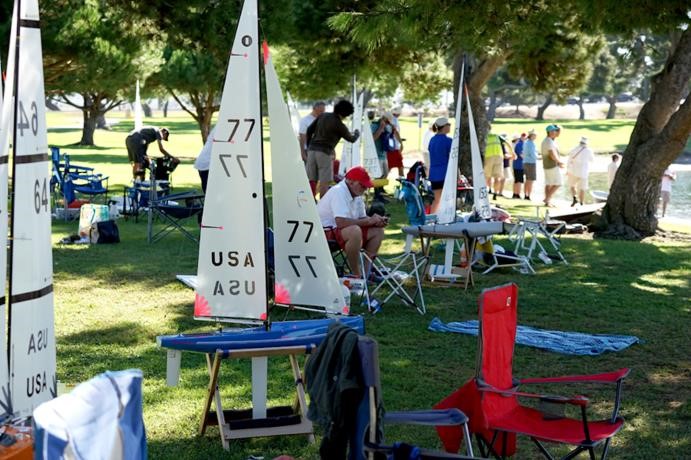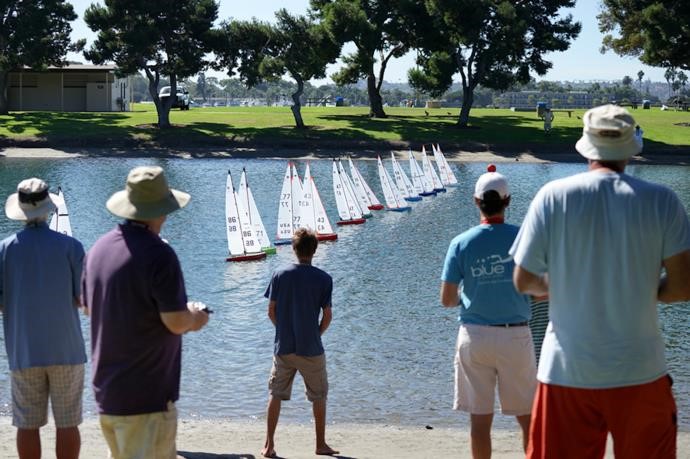
2016 IOM National Championship (October 7-9, 2016)
Mission Bay Model Yacht Pond in San Diego, CA
By Bob Wells
Initially slated for Boise; the venue moved to San Diego where more participation was assured at this bucket list venue that is a more convenient travel destination. And San Diego came through again with 80-degree sunny weather for our 2016 Nationals on the venerable Model Yacht Pond custom built by Parks in the middle of Mission Bay. It could not be more convenient for radio sailors and the pond aligns so well with the dependable onshore breeze. Plus, the host San Diego Argonauts pride themselves on running a first class full service regatta, which this time featured individual custom sandwiches, lots of giveaways, and an excellent catered barbeque Saturday at the venue after racing. This time a club newbie, Bob Hirsch, stepped up as organizer to handle registrations and the many details. The tell of a good organizer is it all works seamlessly with no sign of panic, so good job Bob. PRO Freddie Rocha entertained and cajoled as only he does between races, and his professional race management is a huge contribution to the class. Let’s just say Freddie doesn’t need artificial amplification to be heard. Assisting on the scoring and heat boards was the highly competent Elaine Brown, imported from Oz for race management for this event.
Thursday practice was so much fun visiting and checking out the new kit. I’ve seen the pictures, but this was my first time with Zvonko’s proto Kantun 2 and Tim Brown’s AKA proto, and clearly they are heading in a similar “wider and shallower with mast a little aft” direction. What a treat to talk with the designers about their protos, and both have just started production. George Pedrick has habitually been an early purchaser of Ian Vickers’ designs recently, and on cue he provided my first view of the new V10. His wife Gene now sails his V9, so we got to see them side by side. I can see the subtle differences when George points them out, but it seems more like a V9.3 to me. Safe to say IOM design development is not stagnant in 2016. The overall quality of all the boats and the preparation of them is high too. Well the exception is maybe Toshi’s Micro Brew 5, where the hull is ultra-smooth but too many sanding sessions left the soft paint he prefers thin to non-existent. Not the usual Toshi standard, and his no apology excuse is that his shop time is all directed to his new MB6.
The NoR set aside Friday morning for compliance check, which per usual was headed by Commodore Mike Eldred with IOM Class Secretary Bruce Andersen again assisting him. It is amazing how quickly they could weigh all our batteries, our keels, weigh our boats all-up ready to sail, and float test them. Only 1-rigs were weighed, because you don’t need a 2-rig here. It helps that we mostly all know the drill. All “eventually” passed and we were ready to sail on time, but the wind took a little longer to develop. Unfortunately, some registered skippers did not compete. To name a few: Organizer Bob Hirsch felt pressured to be available for handling the little demands that kept happening, and Bahamian Stan Wallace had Hurricane Mathew to deal with (he’s fine).
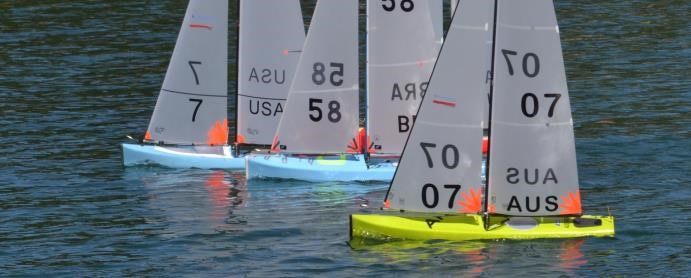
Racing was great, but you have to accept shifty conditions that, “no matter where you are on the course, somebody has better wind than you” (thanks for that John Ebey). The prevailing onshore wind is straight down the narrow-ish rectangular pond with many NW and SW shifts and holes. The skippers job is simple to define; find the shifts and pressure, and to transition efficiently as the wind varies. Not so simple in execution. Mackey says, “This is one of the most difficult venues to sail well at”. Friday I thought it best to hug the south shore most of the time for big gains from that narrow band of better pressure with upwind lifts and downwind headers. Saturday and Sunday, the wind was more square and you used the whole course, but always you searched for shifts and/or pressure. The experienced guys that know this venue have an early advantage, which diminishes as the regatta moves on. Nobody gets it right all the time, and in every leg positions change until you cross the line. And damn those fickle shifts and lulls just before the finish line and weather mark that so affect your outcome! I very much like the challenge of sailing here.
No surprise it was a strong field augmented by skippers from BRA, CRO, and Oz. Everybody but our winner spent some time in B fleet, and some top skippers found themselves fighting to get out of C. Congratulations to our winner, 2009 World Champion Zvonko Jelacic from CRO, who separated himself from the leaders on the last day. From past performance Zvonko was the easy pick for this one, but after two days he was in 2nd just behind John Ebey, who was sailing exceptionally well. USA guys Gary Boell, Craig Mackey, Mark Golison, and Bobby Flack were also all still in the hunt after day 2. The last day Zvonko maintained his consistency to pull away from the pack for the win. Golison made his move with all firsts and 2nds on the last four races and Mackey nearly matched him on those races. They finished tied with Golison getting 2nd on countback. Ebey and his beautifully prepared Fusion finished a few points out for a close 4th. It was nice for a change to see a young guy, Bobby Flack, in top five.
As it should be, those racing quietly focused on the business at hand and spoke only to make a needed hail, then as soon as the race is over the friendly banter resumes. This is the environment I like to race in, absent the distraction of sea lawyers arguing about rule violations in the control area. Sure we missed some sailing time for a couple of protests, but this was a cleanly sailed regatta. Some of the credit for this goes to the observer system the USA class instituted about five years ago, thanks Freddie. All who participated were winners on this great weekend, and it was smiles all around as we packed to depart.
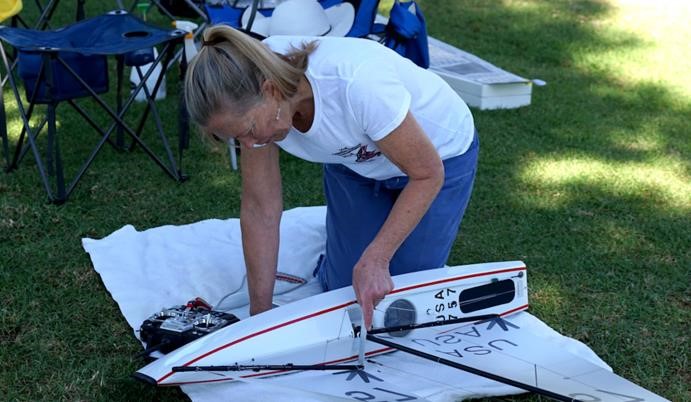
Of course a big IOM event is also very social. Under the shade of the oak trees the pond is a great place to hang out and meet old friends and make new ones. My old friends now include Zvonko and Tim and Elaine Brown from overseas. One of my new friends is Michel Roure from New Jersey, where he sails every Saturday he can at Central Park MYC. He also hopes to form a new sailing club at my Parsippany Lake, NJ. Born in France, he purchased a Brazilian Britpop and picked it up in Foster City last year after Brazil’s Pedro Stier chartered it for Worlds. A nice way to get a new boat that is properly tuned. Worlds is where the very French Michel was hooked by the friendly atmosphere of our international community. Now Michel has purchased another Britpop from Denis Astbury for his Father’s 86th birthday. Sadly, Pedro passed unexpectedly this year, and Michel carries the name Pedro gave the boat, Alforria, in his honor.
Every time I sail here there is always a contingent of Argonaut club members watching and cheering when their boys do well. Friends and significant others are hanging out too, or seeing the sights and shopping. After three IOM regatta visits to San Diego, I don’t think my wife has seen a single heat yet. She does see a lot of San Diego though so we’re both happy. What a great weekend and what a great class. We left with a strong desire to return soon and stay longer. 2017 Midwinters maybe?
Summary of the 2016 IOM National Championship:
- Class: IOM
- Date: October 7-9, 2016 (3 days racing)
- Location: Mission Bay Model Yacht Pond in San Diego, CA
- Host Club: San Diego Argonauts Model Yacht Club
- Entries: 39
- Winds: light – upper middle of 1-rig
- Races Completed: 15 (three heats per race).
- Scoring System: 2014 HMS
- Regatta Committee & Valuable Assistants: Organizer & Registration – Bob Hirsh; PRO, Buoy Boat & Scorekeeper – Fred Rocha; Race Officer: Elaine Brown (AUS); Measurements – Mike Eldred, Bruce Andersen; Food – Mark Halberg; Volunteers – Bob Williams and Rich Rogers.
Special Awards:
- Corinthian Sailor Award – David Woodward
- Best IOM New Sailor – Gabriel Mueller
- Thank You! Award – Elaine Brown
Photos Links:
- http://s181.photobucket.com/user/pamologist/library/2016%20NCR%20San%20Diego%20Argonauts?sort=3&page=1
- https://www.dropbox.com/sh/6ourfqkq7yyzw2q/AACM5rf0nWV3s62lzONAxlWda?dl=0
- http://www.ibextrax.com/RC2016/1007USN/
- Video Link: http://www.rcgroups.com/forums/showthread.php?t=2697607&page=5
- Full Results: http://www.ibextrax.com/RC2016/Results/1007USN.pdf
2016 IOM National Championship – Results after 15 races with 2 throw-outs:
| Position | Skipper | Sail # | City | Hull | Score |
| 1 | Zvonko Jelacic | 35 | Split, CRO | Kantun 2 Proto | 34.0 |
| 2 | Mark Golison | 55 | California, USA | V9 | 59.0 |
| 3 | Craig Mackey | 29 | California, USA | britPOP! | 59.0 |
| 4 | John Ebey | 93 | California, USA | FUSION | 62.0 |
| 5 | Bobby Flack | 96 | Michigan, USA | britPOP! | 71.0 |
| 6 | Gary Boell | 71 | California, USA | NITRO | 96.0 |
| 7 | George Pedrick | 50 | California, USA | V10 | 101.0 |
| 8 | Kelly Martin | 77 | Washington, USA | V8 | 111.3 |
| 9 | Ken Campbell | 181 | California, USA | V8 | 114.5 |
| 10 | Jerry Brower | 42 | Washington, USA | V9 | 116.0 |
| 11 | Steve Toschi | 94 | California, USA | Micro Brew 5 | 124.0 |
| 12 | Gabriel Mueller | 58 | Rio Grande do Sul, BRA | britPOP! | 137.0 |
| 13 | Pedro Loureiro | 88 | Rio Grande do Sul, BRA | britPOP! | 142.0 |
| 14 | Baron Bremer | 81 | Florida, USA | britPOP! | 144.0 |
| 15 | Chris Sullivan | 62 | California, USA | britPOP! | 149.0 |
| 16 | Jon Elmaleh | 2 | New York, USA | New Road 2 | 172.0 |
| 17 | Tim Brown | 07 | Gold Coast, AUS | AKA | 181.0 |
| 18 | Bob Wells | 7 | Washington, USA | Kantun S | 192.0 |
| 19 | Stephan Cohen | 28 | California, USA | britPOP! | 196.0 |
| 20 | Denis Rogers | 43 | California, USA | britPOP! | 218.0 |
| 21 | Bruce Andersen | 16 | Idaho, USA | britPOP! | 258.0 |
| 22 | Scott McConnell | 21 | Washington, USA | Kantun S | 259.0 |
| 23 | Michel Roure | 18 | New Jersey, USA | britPOP! | 263.0 |
| 24 | Joe Damico | 86 | Washington, USA | britPOP! | 271.0 |
| 25 | Larry Stiles | 64 | Washington, USA | britPOP! | 277.0 |
| 26 | Barry Donaher | 47 | Utah, USA | FUSION | 293.0 |
| 27 | Terrance Heyns | 13 | California, USA | Pikanto | 318.0 |
| 28 | Gene Harris | 57 | California, USA | V9 | 321.0 |
| 29 | David Jensen | 68 | Washington, USA | V9 | 334.0 |
| 30 | Mike Eldred | 39 | California, USA | V8 | 339.0 |
| 31 | Jim McCaa | 36 | Washington, USA | Kantun S | 347.0 |
| 32 | Glen Murray | 59 | California, USA | MB5 (Woody) | 348.0 |
| 33 | Steve Washburn | 155 | California, USA | V8 | 354.0 |
| 34 | Kurt Wells | 737 | California, USA | britPOP! | 396.0 |
| 35 | David Woodward | 54 | California, USA | Goth | 397.0 |
| 36 | Ben Reeve | 136 | California, USA | Tempest | 413.0 |
| 37 | Thomas Respess | 90 | California, USA | Micro Brew 4 | 427.0 |
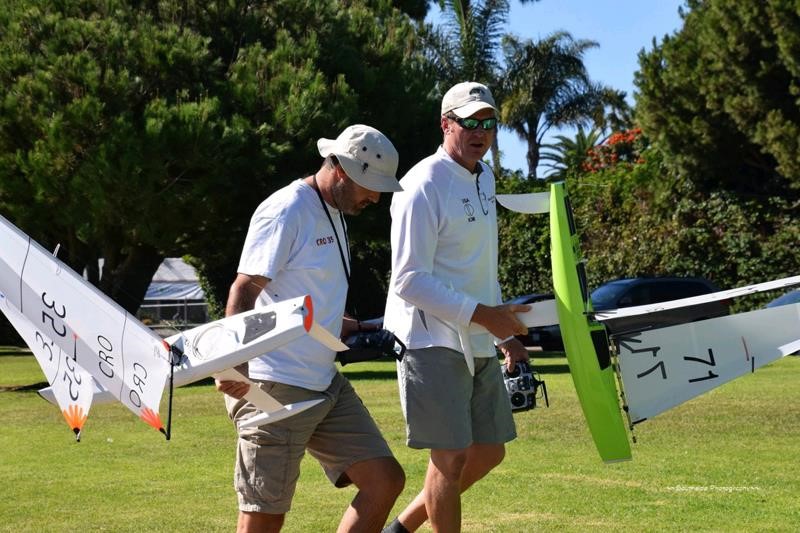
The ‘Bob Wells’ Rule: It is never good when they revise the Sis with a rule named after you… On the first day everybody wanted to sail along the south (or far shore) for the big gains, but my tired eyes were making it very difficult even though the distance wasn’t far. In the upwind congestion I was afraid I would hit someone and downwind I struggled with trim and steering – all due to my vision limitations. Maybe it was the afternoon glare and/or the boats were in shade there, but I was sailing embarrassingly poorly with no confidence.
Then I see Boells go to the south shore to release his grounded boat, and I recognize that I would see much better from that shore. After confirming that was in the control area, I sailed from the far shore my next races and I could see perfectly! What a joy. I could hear the starting tape (barely) and the few hails that went my way, and for the first time I’m sailing at the front of the fleet in a B and then in an A heat. Take away my other issues on those races with my topping lift snagging on my new carbon spreaders, and I would have had my best finishes of the regatta. Next Jerry Brower joined me for the A heat and he much preferred it too – he was in 2nd until a pile-up at the leeward mark left him DFL. For the record, Jerry said afterwards it was caused by the limited visibility from the skippers on the north shore, and if they shared his closer vantage point it would have been a clean rounding for all.
Racing ended for the day and the race committee quietly informed me there would be no more sailing from the south shore, and the official announcement came at the next day’s skipper’s meeting. Initially the concern was ‘unfair advantage’, but after I explained anybody could be there it was agreed that
wasn’t a problem. The official reason to restrict access to the south shore is ‘a communication problem’. So be it.
The next two days’ fewer boats sail along the south shore and my vision was acceptable upwind. Downwind I still struggled with trim and steering at the often preferred south shore though, and I’d say I lost 3-4 boats per leg simple due to vision limitations. After the regatta Zvonko volunteered he noticed my struggles with vision downwind, where too often my sails weren’t powered up or my steering direction was crap. He also gave me a tip: position myself either in front or behind my boat so I can see more of the sails. That should help…
The reason I’m spending so much time on this is I would like the San Diego Argonauts to consider putting the south shore back into the control area. Try it, the radio sailing quality will be better in my not so humble opinion. And you’ll get a nice workout from all the walking to the north side to visit and check the heat board. I can work off the nice lunches you provide.
